Amalthea
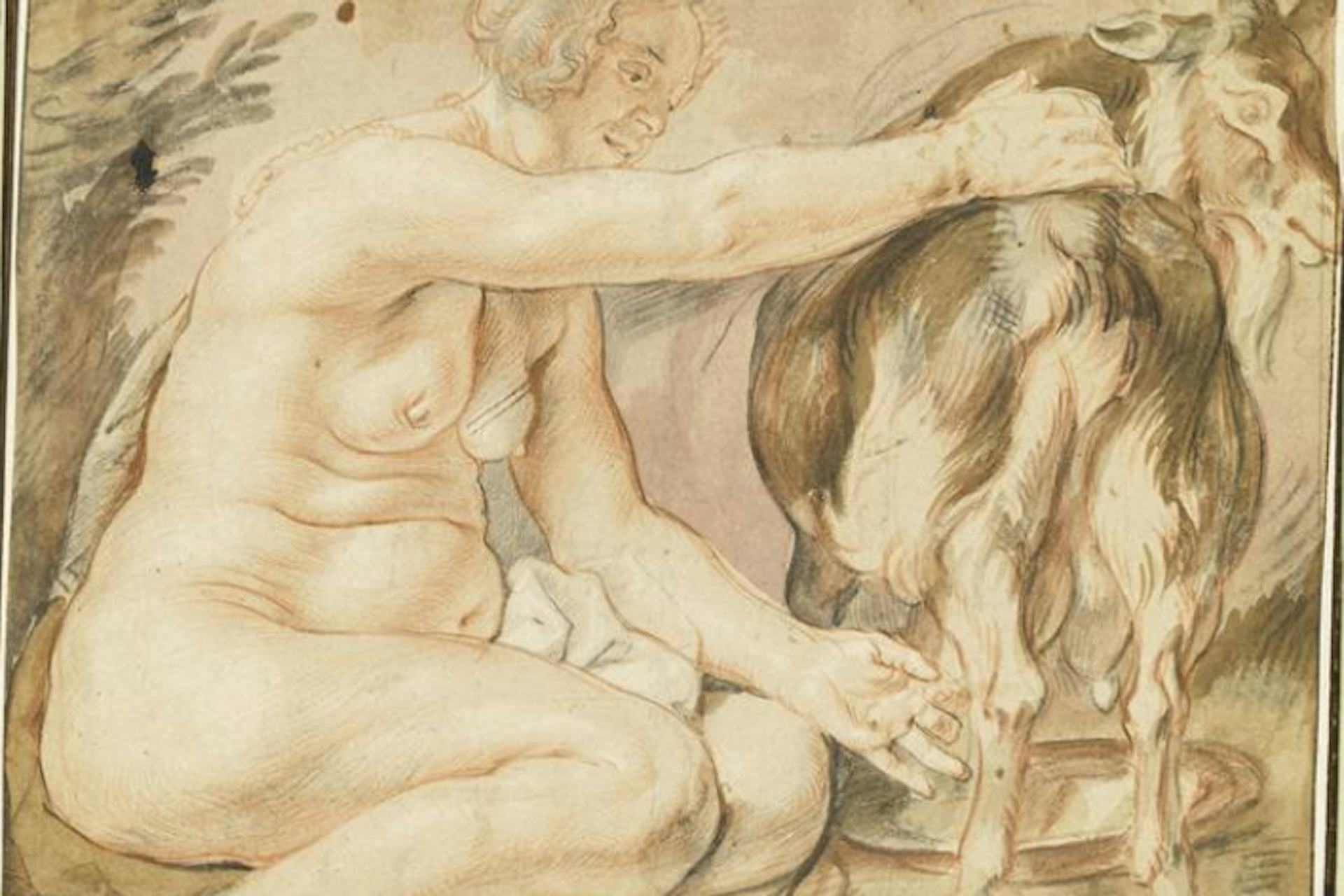
Adrast Milking Goat Amalthea by Jacob Jordaens (between 1600 and 1640)
Louvre Museum, ParisPublic DomainOverview
Amalthea was the nurse and foster mother of Zeus, though ancient sources disagreed on whether she was a nymph or a goat. In either case, she nursed the god Zeus when he was a baby being hidden away from his father Cronus. According to some sources, her main attribute was the original cornucopia, or “horn of plenty.”
Amalthea’s mythology varied depending on which version of her identity was accepted. In the version that made her a nymph, Amalthea was a figure of fertility. She was connected with various gods, including her fellow nymphs and the river god Achelous.
In the version that made Amalthea a goat, on the other hand, much attention was given to the honors lavished upon her after her death. Some claimed that Zeus turned her into the constellation Capra (the “goat”), while others said that he placed her skin over the aegis, his famous shield.
Etymology
The etymology of the name “Amalthea” (Greek Ἀμάλθεια, translit. Amáltheia) is uncertain. The second part of her name is seemingly connected to the Greek word for “goddess,” θεά (theá). The first part, however, is more difficult to parse. It may be connected to the adjective ἀμαλός (amalós), meaning “gentle,” or to the noun ἄμαλλα (ámalla) or ἀμάλη (amálē), meaning “sheaf of corn.”
In either case, Amalthea’s name seems to reflect her role as a nurturing, maternal figure.
Pronunciation
English
Greek
Amalthea Ἀμάλθεια (Amáltheia) Phonetic
IPA
[am-uhl-THEE-uh] /ˌæm əlˈθi ə/
Attributes
Amalthea’s attributes as a nymph are distinct from her attributes as a goat. There is no clear consensus on which of these forms was the “true” Amalthea.
As a Nymph
Some sources made Amalthea a nymph, perhaps a Naiad or water nymph.[1] Her homeland, it was usually said, was on the island of Crete, where Zeus was hidden and raised as a baby.
As a nymph, Amalthea was said to possess a magical horn of plenty—what the Romans (and contemporary readers) would call a “cornucopia.” This horn could supply anyone who held it with an inexhaustible supply of food or drink.[2]
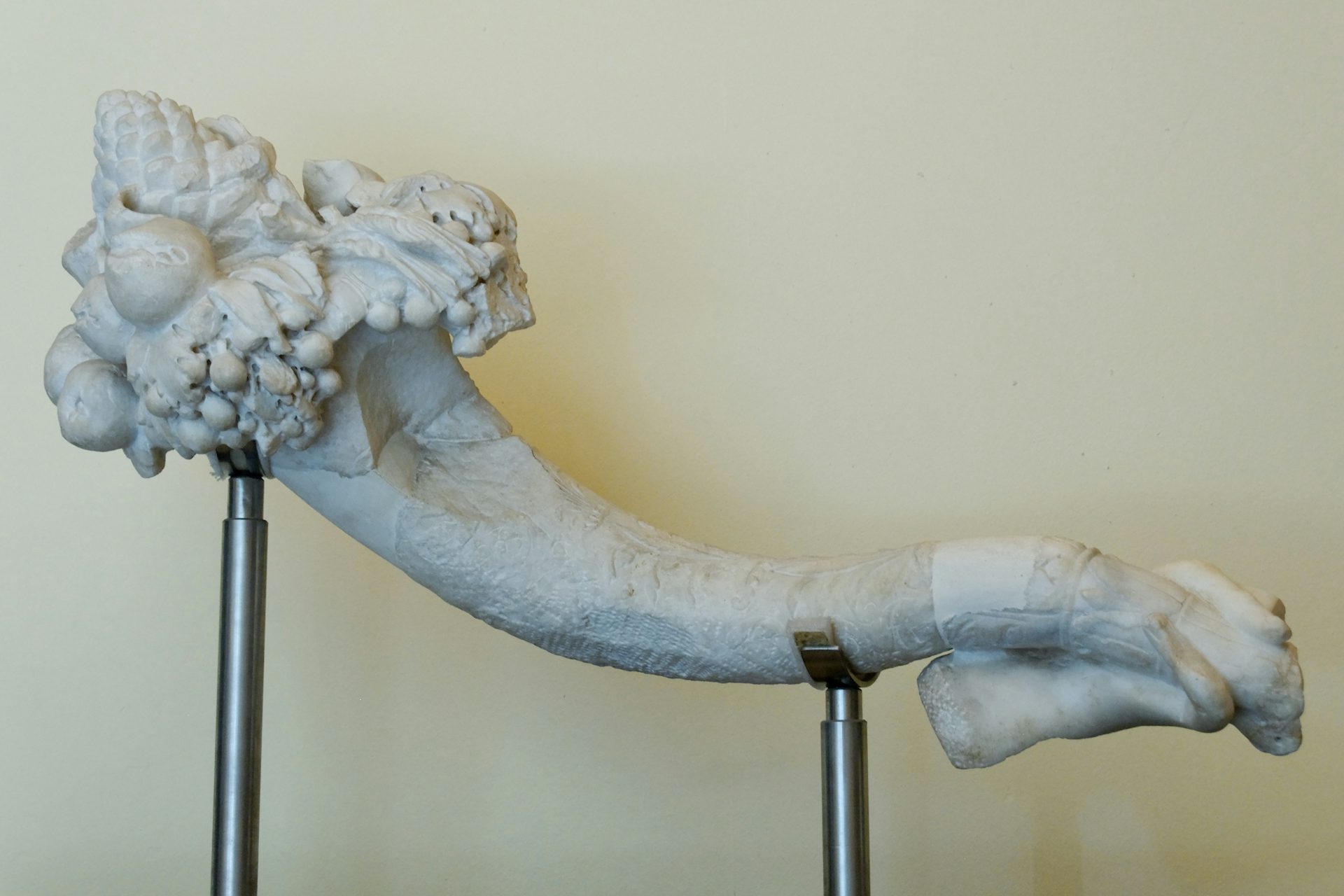
Marble statue of a cornucopia with grapes, vine leaves, ears of corn, pomegranates, apples and a pine cone; of the female figure that would have originally been holding the cornucopia only the hand remains (1st century CE). From Tindari in the province of Messina, Italy.
Regional Archaeological Museum Antonio Salina, Palermo, Sicily / Marie-Lan NguyenCC BY-SA 2.5According to one tradition, Amalthea’s horn originally came from one of her goats, who had broken off her horn on a tree. Amalthea took the horn, filled it with various types of fruits, and used it to feed the baby Zeus.[3]
According to another tradition, it was Zeus who gave this horn to the nymphs as a gift, taking it from the goat that had nursed him and endowing it with special powers.[4]
In many traditions, Amalthea was described as the nymph who owned the goat whose milk was used to nurse Zeus.
As a She-Goat
For other ancient authorities, Amalthea was the name of the goat who suckled Zeus, rather than the nymph who owned the goat.[5]
In the most familiar tradition, Amalthea the goat nursed Zeus in Crete, on Mount Dicte or Mount Ida. But there was another tradition in which Zeus was nursed in Arcadia,[6] in either the town of Olenus or nearby at Aegion.[7]
As a goat, Amalthea was imagined as a kindly and gentle creature. One source added that she often bore twin kids.[8] Another source claimed she had a guard dog to protect her while she suckled the baby Zeus with her milk.[9]
Other accounts were even more fabulous: in one, for example, we hear that ambrosia flowed from one of her horns and nectar from the other. As these were the food and drink of the gods, they would have made a fitting meal for the future king of the gods.[10]
When Amalthea (the goat) died, Zeus sought to honor her for all eternity. In one tradition, he did this by transforming her (and perhaps her kids as well) into a constellation—specifically, the constellation Capra, the “goat” (alternatively known as Auriga, the “charioteer”).[11] In another tradition, Zeus skinned the dead Amalthea and placed her hide on his shield, the aegis.[12]
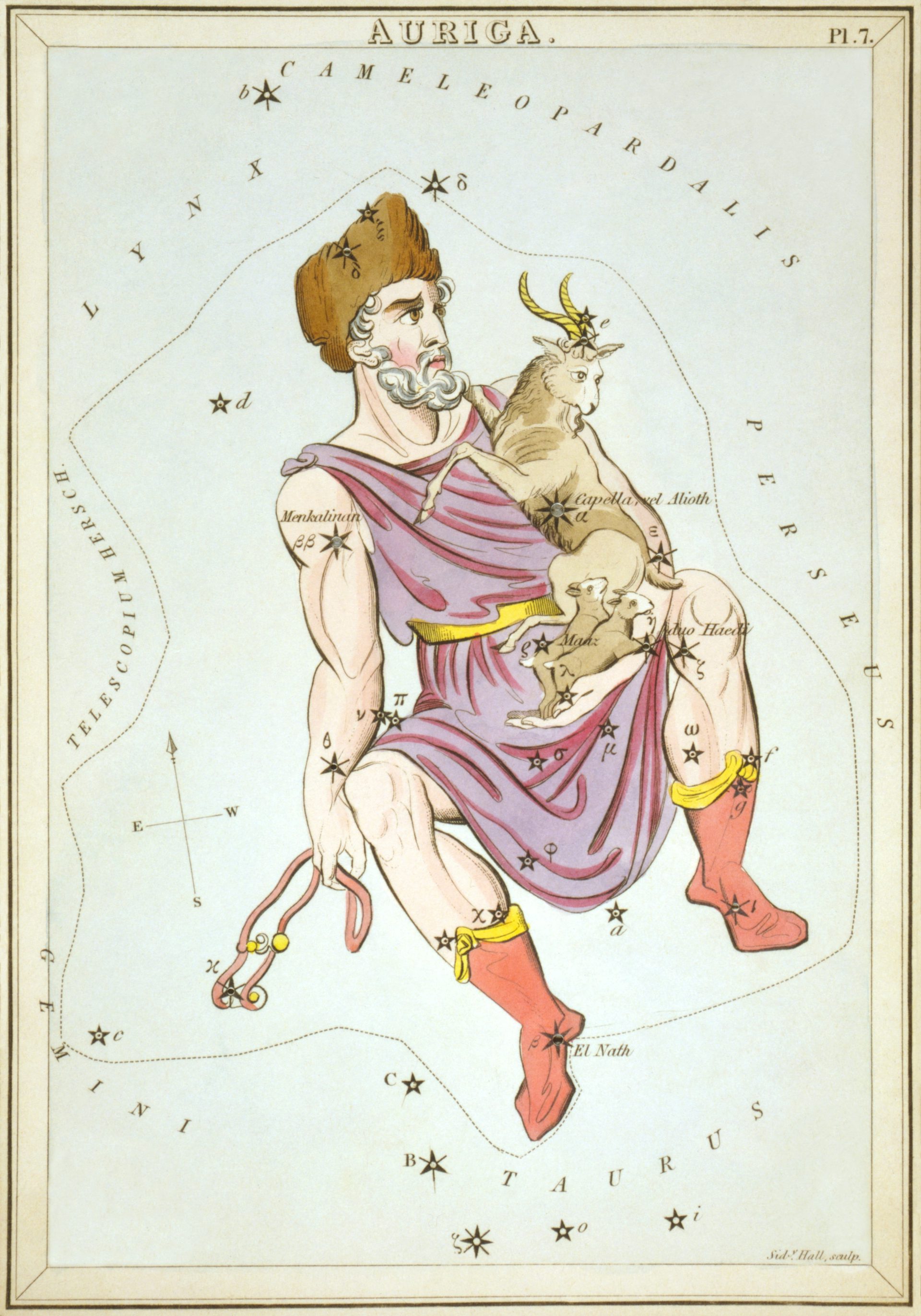
Illustration of the constellation Auriga, which includes on the right the goat Amalthea and her kids
Sidney Hall’s Urania's Mirror (1825). Restored by Adan CuerdenPublic DomainIconography
Amalthea rarely appeared in ancient art; most representations are from the first century BCE or later. It appears that Amalthea was usually represented as a she-goat suckling Zeus—though it is possible that the goat shown in these scenes was meant to be the goat belonging to the nymph Amalthea. Some artists did represent Amalthea as a nymph, usually showing her holding Zeus and the cornucopia.[13]
Family
The sources that made Amalthea a she-goat had little to say about her family (she was, after all, a goat). Those that made Amalthea a nymph tried to identify her parentage, but no real consensus ever emerged.
Thus, in one tradition Amalthea’s father was called Haemonius;[14] in another he was the Titan Oceanus;[15] in another he was Olenus, a son of Hephaestus;[16] and in another he was the Cretan king Melisseus.[17] Amalthea’s mother is not named in any extant source.
Mythology
Origins
The earliest sources on Zeus’ infancy do not mention any Amalthea (whether goat or nymph).[18] Indeed, the myth of Amalthea does not seem to have become popular until the Hellenistic period (323–30 BCE).
Even so, hints of the notion that Zeus was nursed by a she-goat can be detected from a very early date. Hesiod, for example, who may have lived as early as the eighth century BCE, said in the Theogony that Zeus was hidden and nursed in a place called Mount Aegaeon—literally, “Goat Mountain.”[19]
Other traditions stated that Zeus’ nurse was named Aex, identified as either a nymph or a hideous Gorgon-like daughter of the sun god Helios.[20] These traditions also highlighted Zeus’ goatish upbringing, as the name Aex is identical with the Greek word meaning “goat.”
The fact that Amalthea’s mythology is so conflicted and contradictory is likely significant. It suggests that there were numerous local variants of her and her mythology, and even that she was worshipped in very different ways across the Greek world. Her connection with the cornucopia indicates that she may have originally been a goddess of abundance, nurturing, or fertility.
The Infancy of Zeus
When Zeus was just a baby, his mother Rhea had to hide him from his father, the Titan Cronus.
Cronus, who had taken control of the universe from his father Uranus, had learned from an oracle that he too would be overthrown by one of his children. To thwart this prophecy, Cronus decided to swallow each of his children as soon as they were born.
But when Cronus’ wife Rhea gave birth to their youngest child, Zeus, she deceived her husband by giving him a stone to swallow instead of the baby. She then spirited Zeus away to be raised in secret.
Zeus was nursed and raised by the nymphs of Crete (or, in another tradition, by the nymphs of Arcadia). They fed him with honey and goat’s milk—either milk from the she-goat Amalthea or from a she-goat owned by the nymph Amalthea.
As these nymphs sought to protect Zeus from his father, they had help from the Corybantes, mysterious rustic gods who danced around the baby Zeus and clashed their arms together so that Cronus would not hear his son’s cries. The scene is vividly described by the poet Callimachus:
… thee, O Zeus, the companions of the Cyrbantes [the Corybantes] took to their arms, even the Dictaean Meliae, and Adrasteia laid thee to rest in a cradle of gold, and thou didst suck the rich teat of the she-goat Amaltheia, and thereto eat the sweet honey-comb.[21]
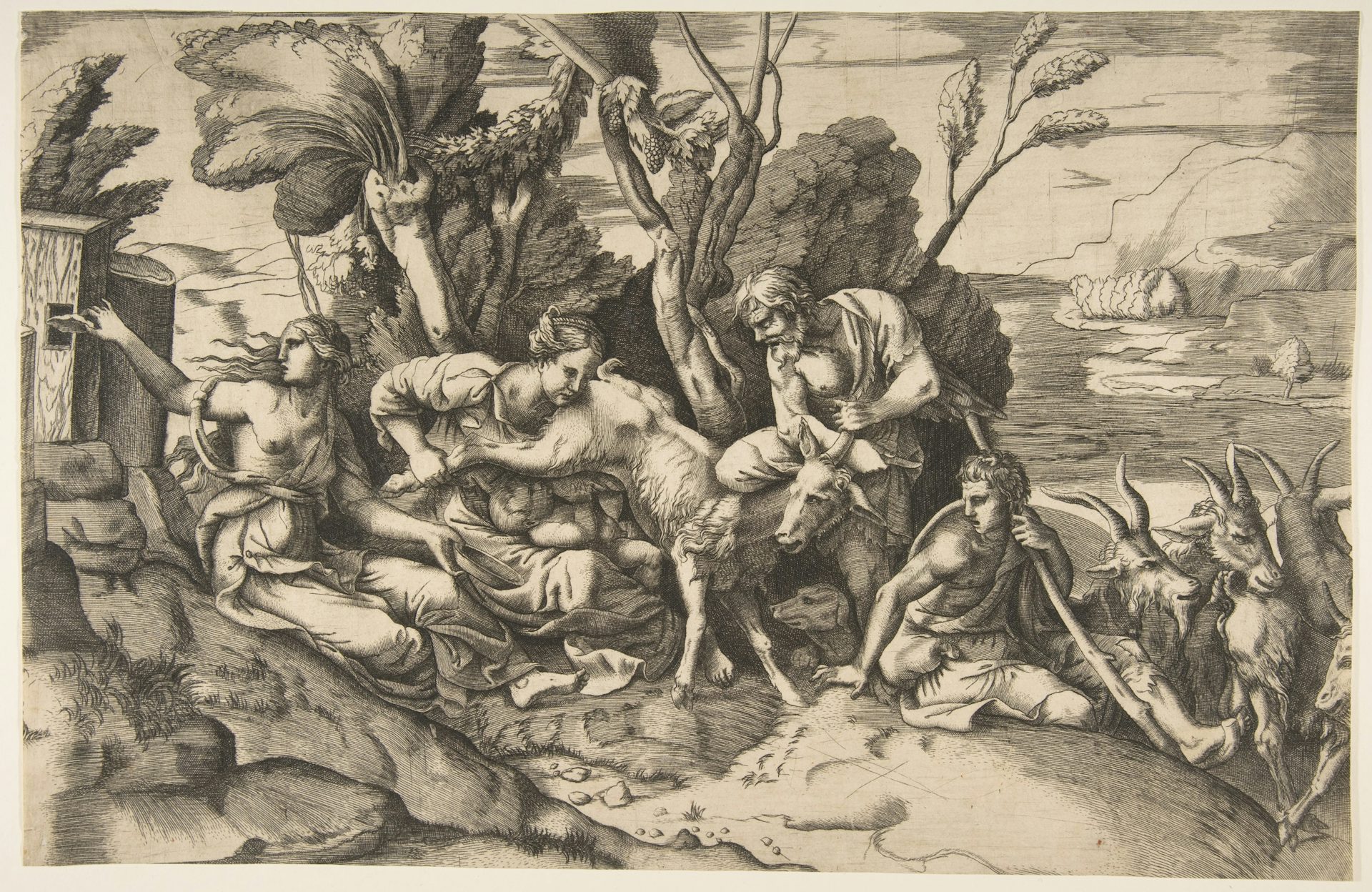
Jupiter Suckled by the Goat Amalthea by Giulio Bonasone (1531–1576)
The Metropolitan Museum of ArtPublic DomainIn another tradition, Amalthea hung Zeus’ cradle on a tree. In this way, Zeus remained outside of his father’s domains—the sky, the earth, and the sea—and thus out of his reach.[22]
Amalthea and Achelous
Amalthea the nymph appears in at least one other myth involving the hero Heracles and the river god Achelous.
Both Heracles and Achelous had come to the city of Calydon to seek the hand of the beautiful princess Deianira in marriage. Things soon turned violent, however, and a fight broke out between Heracles and Achelous. Achelous tried to gore Heracles by transforming himself into a bull, but Heracles beat him by ripping one of the horns from Achelous’ head.
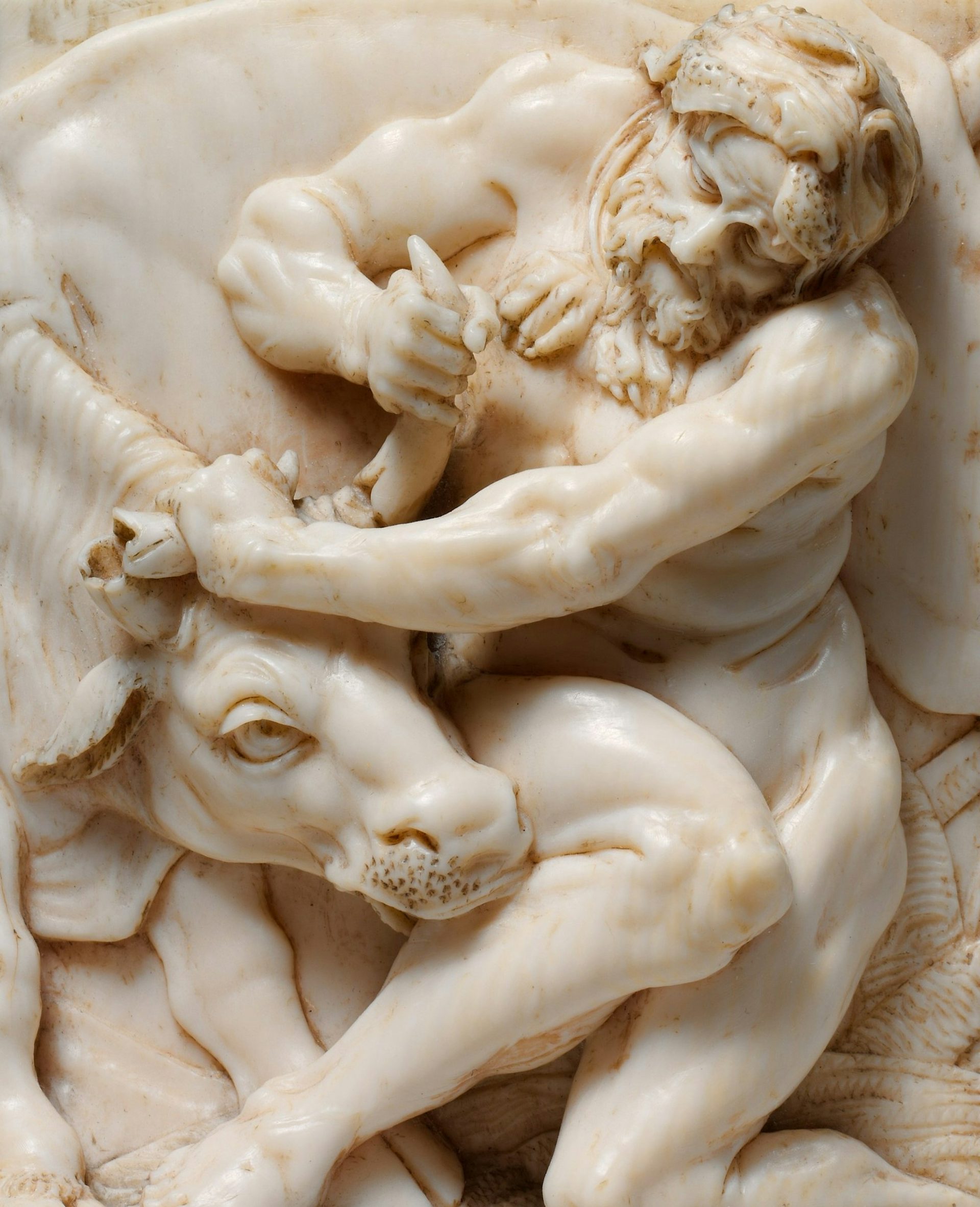
Hercules and Achelous (in the Form of a Bull). Attributed to the Master of the Martyrdom of St. Sebastian (ca. 1670).
The Metropolitan Museum of ArtPublic DomainAchelous, who had lost both his horn and his bride, slunk away. But Amalthea, it seems, took pity on him. She gave him her horn of plenty, which Achelous was able to trade with Heracles in exchange for his own horn.[23]
Worship
Little is known about the worship of Amalthea, though there is reason to believe that she was once some kind of fertility or mother goddess. She survived in the imagination of the ancient Greeks in the form of a constellation, into which she was sometimes said to have been transformed by Zeus.
Amalthea’s horn of plenty was also an important symbol in antiquity—one that seems to have had some religious significance. Miltiades, the famous Athenian general who defeated the Persians at the Battle of Marathon, even dedicated an ivory “horn of Amalthea” in the Sicyonian Treasury at Olympia.[24]